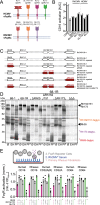Rhesus Cytomegalovirus-encoded Fcγ-binding glycoproteins facilitate viral evasion from IgG-mediated humoral immunity
- PMID: 39885150
- PMCID: PMC11782611
- DOI: 10.1038/s41467-025-56419-3
Rhesus Cytomegalovirus-encoded Fcγ-binding glycoproteins facilitate viral evasion from IgG-mediated humoral immunity
Abstract
Human cytomegalovirus (HCMV) encodes four viral Fc-gamma receptors (vFcγRs) that counteract antibody-mediated activation in vitro, but their role in infection and pathogenesis is unknown. To examine their in vivo function in an animal model evolutionarily closely related to humans, we identified and characterized Rh05, Rh152/151 and Rh173 as the complete set of vFcγRs encoded by rhesus CMV (RhCMV). Each one of these proteins displays functional similarities to their prospective HCMV orthologs with respect to antagonizing host FcγR activation in vitro. When RhCMV-naïve male rhesus macaques were infected with vFcγR-deleted RhCMV, peak plasma DNAemia levels and anti-RhCMV antibody responses were comparable to wildtype infections of both male and female animals. However, the duration of plasma DNAemia was significantly shortened in immunocompetent, but not in CD4 + T cell-depleted animals. Since vFcγRs were not required for superinfection of rhesus macaques, we conclude that these proteins can prolong lytic replication during primary infection by evading virus-specific adaptive immune responses, particularly antibodies.
© 2025. The Author(s).
Conflict of interest statement
Competing interests: S.R.P. has served as a consultant to Merck, Moderna, Pfizer, GSK and Dynavax and has led sponsored programs with Moderna and Merck. P.K. has received funding from Biotest AG. None of these activities have impacted this work. The remaining authors declare no competing interests.
Figures





Update of
-
Rhesus Cytomegalovirus-encoded Fcγ-binding glycoproteins facilitate viral evasion from IgG-mediated humoral immunity.bioRxiv [Preprint]. 2024 Feb 28:2024.02.27.582371. doi: 10.1101/2024.02.27.582371. bioRxiv. 2024. Update in: Nat Commun. 2025 Jan 31;16(1):1200. doi: 10.1038/s41467-025-56419-3. PMID: 38464092 Free PMC article. Updated. Preprint.
References
-
- Takenaka, K. et al. Cytomegalovirus reactivation after sllogeneic hematopoietic stem cell transplantation is associated with a reduced risk of relapse in patients with acute myeloid Leukemia who survived to day 100 after transplantation: The Japan society for hematopoietic cell transplantation transplantation-related complication working group. Biol. Blood Marrow Transpl.21, 2008–2016 (2015). - PubMed
MeSH terms
Substances
Grants and funding
- S10 OD016261/OD/NIH HHS/United States
- KO6815/1-11/Deutsche Forschungsgemeinschaft (German Research Foundation)
- T32-CA009111/U.S. Department of Health & Human Services | National Institutes of Health (NIH)
- R24 OD010976/OD/NIH HHS/United States
- OD011104/U.S. Department of Health & Human Services | NIH | National Center for Research Resources (NCRR)
- P51-OD011107/U.S. Department of Health & Human Services | National Institutes of Health (NIH)
- UL1TR002553/U.S. Department of Health & Human Services | NIH | National Center for Advancing Translational Sciences (NCATS)
- P51 OD011092/OD/NIH HHS/United States
- HE2526/9-2/Deutsche Forschungsgemeinschaft (German Research Foundation)
- 3P01AI129859/U.S. Department of Health & Human Services | NIH | National Institute of Allergy and Infectious Diseases (NIAID)
- TL1 TR002386/TR/NCATS NIH HHS/United States
- DP2 HD075699/HD/NICHD NIH HHS/United States
- P51 OD011107/OD/NIH HHS/United States
- 2TL1-TR-2386/U.S. Department of Health & Human Services | National Institutes of Health (NIH)
- P51OD011092/U.S. Department of Health & Human Services | National Institutes of Health (NIH)
- P51 OD011104/OD/NIH HHS/United States
- 3P01AI129859-04S1/U.S. Department of Health & Human Services | NIH | National Institute of Allergy and Infectious Diseases (NIAID)
- OD016261/U.S. Department of Health & Human Services | National Institutes of Health (NIH)
- T32 CA009111/CA/NCI NIH HHS/United States
- UL1 TR002553/TR/NCATS NIH HHS/United States
- P01 AI129859/AI/NIAID NIH HHS/United States
- DP2HD075699/U.S. Department of Health & Human Services | NIH | Eunice Kennedy Shriver National Institute of Child Health and Human Development (NICHD)
- HHSN272201300031C/AI/NIAID NIH HHS/United States

